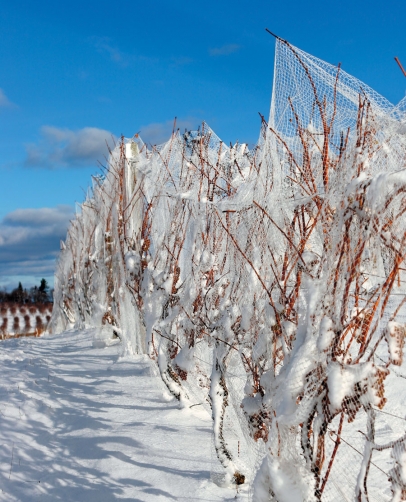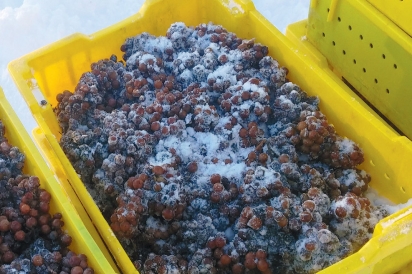Nectars of the North
From the four seasons of Northern Michigan comes another great gift—the sweetness of wine winter-harvested and crafted as a labor of love. For romance or just spreading warmth on a snow-filled night, these vinted treasures can double down with your dessert or stand alone—as ambrosia for the mouth and the heart.
In the world of wine, dessert wines are a category to themselves, a category that could be called deliciousness in a glass. Within that are several styles—not all dessert wines are ice wines!—that can be easily found on the wine trails of Northern Michigan.
Dessert wines come in red, white, even rosé, and are produced around the world. Some of the most famous have long traditions and originate from the great European wine-growing regions. Their familiar names include Sauternes, Eiswein, Port and Tokaji.
The prominent characteristic of these wines is an unusually high residual sugar content. In order to balance this level of sweetness, the wines also need to have a firm backbone of acidity, and that is why certain varietals are more commonly used for these styles. The combination of concentrated sugar and acidity allows most dessert wines to have great aging potential, which helps account for their sometimes steeper price tags.
Each of the following styles uses natural processes that remove water from the grapes, concentrating the flavors and sugars while maintaining high acid levels and, in some cases, high alcohol levels, to prevent cloying sweetness.
LATE HARVEST
Late-harvest wines begin with just what you think, a later-than-normal harvest! During the extra hang time—typically one or two months after the regular harvest—the grapes begin to reduce in water content and increase in sugar content as well as in weight.
In the making of these wines, the vintner stops the fermentation process naturally before the yeast can consume all the sugar. While any wine grape can be harvested late, certain grapes (Riesling, Sauvignon Blanc, Gewürztraminer, Vidal Blanc) have the capability to produce exceptionally high-quality late-harvest wines.
ICE WINE
Ice wine, or eiswein (ICE-vyne) in German, is created by allowing the grapes to be left on the vine into the winter to freeze. As it is with the late-harvest style, water content is dramatically decreased and sugar content is increased. But the key thing with ice wine is that the grapes are harvested and pressed while the grapes are so frozen that any remaining water is crystalized and the liquid is a sweet concentrated juice. The grapes for ice wine need to be healthy and should not be affected by noble rot (see below).
Traditional ice wine is by definition a labor of love. Committing a portion of a year’s vintage to ice wine production is a gamble because the freezing might not come before the grapes rot or are lost. The trellises need netting and the entire crop needs to be picked by hand in frigid conditions within a few hours and at the right temperature. The changing climate has been affecting the production of ice wine, particularly in Germany. While Germany and Canada are the most famous producers, Michigan’s climate has conditions that allow for ice wine production as well.
Another technique for making ice wine is known as a cryoextraction. Grapes are picked and cleaned, then placed into a freezing unit and brought to a temperature of 20 degrees Fahrenheit. They are pressed at this temperature. Same as in the traditional method, the concentrated juice drains off while ice crystals usually remain in the press.
FORTIFIED
Sherry, Port and Madeira are the most popular fortified dessert wines. Fortification is the process of adding a distillate (usually un-aged grape brandy) during or near the end of fermentation. By adding alcohol to the fermenting grape “must” the yeast is killed. Fermentation stops and the remaining sugar (residual sugar) is left in the wine. “Ports” in Northern Michigan are often made with cherry wines or spirits.
NOBLE ROT
Noble rot sounds rather unpleasant but it’s not. Its Latin name, Botrytis cinerea, describes the “friendly” fungus that grows on certain grapes when conditions are optimal for this type of rot. It causes the grape skins to break, allowing the juice and pulp to become affected by the mold and reducing the water content by about one-third. This is simply another way the flavors of the grape are concentrated. The most famous (and very expensive) white dessert wine, Château d’Yquem, is made from Sauvignon Blanc and Semillon grapes affected by the noble rot. This wine from Sauternes in Bordeaux, France, can age for decades.
TOKAJI
Tokaji is a Hungarian wine made from only six native grape varieties. Way back in the times of Peter the Great, King Louis XIV and Catherine the Great these wines were considered the finest on the planet. Their sweetness level is indicated by “puttonyo” icons on the label that reflect the amount of noble rot grapes added in production. The higher the number of puttonyos the sweeter the wine.
TO PAIR OR NOT TO PAIR
These wines may be paired with desserts or enjoyed as dessert all by themselves. Aside from your personal preferences, the wine should be sweeter than the dessert. While there are exceptions to this standard, they are rather risky. Why? If the dessert is sweeter than the wine, the wine will taste bitter, flat and sour, no matter how exquisite the wine. Even Chateau d’Yquem would be annihilated by a dessert that’s sweeter than the wine. Another guideline is that it’s best to pair the color of the wine with the color of the dessert. As the dessert gets darker, so should the wine. By the way, as white wine ages it becomes darker in color, while red wine becomes lighter.
Sweetness is the first of three considerations in matching wines with dessert. Secondly, we need to ascertain the acidity of the pairing partners. Fruity desserts contain acid in the fruit itself, thereby pairing well with wines with a bit of acidity. Lastly, the more intense the dessert the more intense should be the dessert wine.
Desserts with a custard or vanilla focus are usually lighter in appearance, flavor and texture than other desserts. Panna cotta, flan, rice pudding and creme brulee are complemented by lighter wines. Late-harvest Rieslings, other late-harvest varietals and off-dry sparkling wines are all excellent partners for lighter desserts. Fruity desserts, including tarts, turnovers and pavlovas, taste even better when partnered with dessert wines having flavors similar to the dessert. Ice wines are traditional matches for fruit-focused desserts but they are truly best savored all by themselves.
Dessert wines are usually served in small glasses because a little goes a long way. But it may be better to serve your “stickie” in a larger glass to enable you and your guests to enjoy the amazing aromas and gorgeous colors these wines display!
Michigan Dessert Wines
Many wineries in Northwest Lower Michigan produce dessert wines, from late harvests to ice wines to ports and fortified fruit wines. We’ve selected just a few to sample here. Wintertime is a perfect time to explore these styles and warm up with their sweetness.
Bel Lago 2014 Select Harvest Riesling
Charlie Edson, winemaker at Bel Lago, known as “the professor” to his colleagues, made a lighter-styled dessert wine recently. His 2014 Select Harvest Riesling is the perfect accompaniment to peach pie. “Aromas of tropical fruits, peaches and pears invite you to enjoy this wine,” says Charlie. There is just a bit of minerality and petrol on the finish of this charmer.
Chateau Chantal Entice
Mark Johnson is not only one of the most experienced winemakers around he’s also a lot of fun and very creative. Chateau Chantal’s Entice is an unusual wine. Riesling ice wine is “fortified with our own oak-aged brandy for something special. It’s made like a port, but with our Northern Michigan twist.” Soft, rich, creamy cheeses will enhance this unique dessert wine.
Forty-Five North 2013 Ice Wine Riesling
In his first year as full-time winemaker at Forty-Five North Vineyard & Winery Jay Briggs made an outstanding traditional ice wine. His 2013 Ice Wine Riesling is luscious with aromas of pineapple, honey, apricots and peaches. Jay recalls, “Before sunrise could offer even a glimmer of warmth, we bundled up and headed out on this blustery 9-degree morning to harvest the frozen grapes.” Savor this wine without accompaniment. Best of Class in the 2015 Michigan Wine Competition.
Mackinaw Trail 2013 Vidal Blanc Ice Wine
Mackinaw Trail Winery in Petoskey is one of the newer wineries crafting ice wine. This traditional ice wine from Vidal Blanc grapes sourced from the Lake Michigan Shore AVA is luxurious. Winemaker Matt Killman says, “The grapes were picked at the end of December from a large harvest. Our labor of love is meant to be savored slowly.” Their 2013 Vidal Blanc Ice Wine is rich, almost creamy in texture. Redolent of honeyed apricots and peaches on the nose, the palate is sweet with a bit of butterscotch. It finishes long and luscious but with a classic zip of acidity balancing the sweetness.






